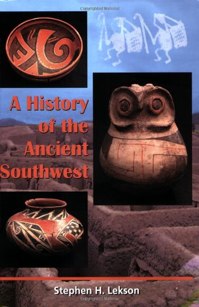A History Of The Ancient Southwest
In this daring and dazzling overview of the field and its history, Stephen Lekson interweaves the history of the Southwest and the history of Southwestern archaeology. This dual narrative turns out not to be an affectation, for our ideas of how Anasazi and Hohokam people lived were deeply shaped by personalities and institutional histories. In particular, the presence of a border between Mexico and North America has separated Chihuahua from Arizona and New Mexico in a way that would have been invisible and absurd to the fourteenth century.
Lekson builds his conjectural history from a number of fundamental assertions, some of which differ dramatically from American archaeological convention. He asserts that “distance could be managed” – that people knew a lot about what was happening hundreds or thousands of miles away. Their knowledge wasn’t exact and it wasn’t current, but because people doubtless heard stories and repeated them, Lekson assumes that the Anasazi knew something about Mesoamerica far to the South, and also something about Cahokia far to the East. When “the Turk” led Coronado and company from Pecos out into the great plains, Lekson thinks, he knew exactly where he was going and what they would find on the banks of the Mississippi – he just hadn’t received the memo that the great Mississipian city had collapsed a few centuries ago.
Similarly, Lekson is very reluctant to accept temporal coincidences. If two events happen in sequence, he is happier to assume a causal sequence or a common antecedent than to posit mere coincidence.
The historical (rather than methodological) idea that really matters here is a fresh interpretation of Pueblo IV as a deliberate ideological rejection of the Chaco phenomenon. The Pueblos were not always peaceful and egalitarian; as Lekson wrote in The Chaco Meridian,
Does all this sound anthropologically familiar? If I were describing a neolithic center in Turkistan or Shansi or Wessex or Bolivia or Illinois, what would we think? Chaco was socially and politically ‘complex’ — that is, a hierarchy with definite haves and have-nots. Hierarchy, not heterarchy: A few people at Chaco regularly and customarily directed the actions of many other people, and those few lived in more expensive houses and had more baubles (at least in death) than the many. Were they chiefs, priests, kings, queens, duly-elected representatives? Who knows? And, for now, who cares? They were elite leaders, Major Dudes: that much seems clear. If ever anyone in the Pueblo Southwest were elite, it was those two guys buried in the famous log crypts of Old Bonito. Those boys had power.
Lekson rejects the language of critical theory as emphatically as the heirs of Mimbres rejected its traditional iconography. That’s interesting, and he has developed a supple and flexible informality that combines precision and concision with a disarming accessibility. This is in many ways a brave book, one whose conclusions will not always suit its readers’ politics. Lekson’s history may not be the past that contemporary Southwesterners would like to imagine, but this fascinating and beautifully-argued reexamination of the evidence restores to the Southwestern past the possibility that history happened there.
